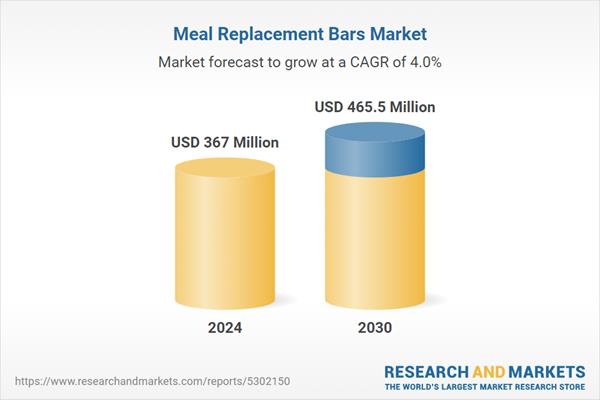Global Meal Replacement Bars Market - Key Trends and Drivers Summarized
How Do Meal Replacement Bars Provide Balanced Nutrition on the Go?
Meal replacement bars have surged in popularity as a convenient and nutritionally balanced option for those with hectic lifestyles, fitness enthusiasts, and anyone looking to manage their diet more effectively. These bars are formulated to deliver a complete set of macronutrients - carbohydrates, proteins, and fats - along with essential vitamins and minerals, making them suitable substitutes for traditional meals. By offering a portable and easy-to-consume format, meal replacement bars cater to individuals who struggle to find time for proper meals, ensuring that they can meet their daily nutritional needs even when on the move. Unlike regular snack bars, meal replacement bars are designed to offer more substantial calories, typically between 200 and 400 per serving, along with a balanced profile of fiber, proteins, and healthy fats that help maintain satiety and prevent energy crashes. They often include ingredients such as whey protein, soy protein isolates, nuts, seeds, whole grains, and natural sweeteners to create a balanced nutritional profile. Moreover, many meal replacement bars are fortified with additional nutrients, including omega-3 fatty acids, probiotics, and antioxidants, to support overall health. With options tailored to various dietary preferences such as gluten-free, dairy-free, and low-sugar formulations, meal replacement bars have become a go-to solution for busy professionals, athletes, and health-conscious consumers looking for quick, nutritious meal alternatives.What Innovations Are Driving the Evolution of Meal Replacement Bars?
The evolution of meal replacement bars is being fueled by advancements in ingredient technology, enhanced formulations, and a growing focus on functionality and flavor. One major area of innovation is the improvement in protein sources and blends, as manufacturers move beyond traditional whey and soy proteins to incorporate alternative proteins like pea, rice, hemp, and cricket protein. These sources not only cater to plant-based and environmentally conscious consumers but also provide a broader range of amino acids, making the bars suitable for various dietary needs. The use of slow-release carbohydrates like oats, quinoa, and sweet potatoes is another trend, as these ingredients provide sustained energy levels compared to fast-digesting sugars and refined grains. Moreover, manufacturers are exploring ways to incorporate functional ingredients such as MCT oil, collagen peptides, adaptogens like ashwagandha, and superfoods like spirulina and chia seeds, turning meal replacement bars into multifunctional health products that can support weight management, enhance cognitive function, or promote gut health. Another key innovation is the inclusion of flavor-masking and texture-enhancing technologies, which have significantly improved the taste and mouthfeel of these bars, addressing one of the primary consumer complaints about the category. The development of sophisticated sweetener blends, using natural alternatives like monk fruit and allulose, helps maintain palatability without compromising the low-sugar content that health-conscious consumers seek.Where Are Meal Replacement Bars Being Positioned, and What Benefits Do They Offer to Different Consumer Segments?
Meal replacement bars are being strategically positioned in various markets to cater to distinct consumer segments, ranging from athletes and fitness enthusiasts to busy professionals, weight-conscious individuals, and travelers. In the fitness and sports nutrition market, meal replacement bars are promoted as a convenient source of high-quality protein and complex carbohydrates that aid in muscle recovery and provide sustained energy for long workouts. Their balanced nutritional profile makes them ideal for pre- and post-workout consumption, supporting both endurance and strength-training regimens. Among weight-conscious consumers, these bars serve as portion-controlled meals that help manage calorie intake and curb cravings without sacrificing nutritional quality. Meal replacement bars designed for weight management often feature higher fiber content and added ingredients like green tea extract or L-carnitine to boost metabolism and support fat loss. For professionals with demanding schedules, these bars are marketed as time-saving solutions that eliminate the need for unhealthy fast food options, providing a quick, wholesome meal that can be consumed anywhere. Additionally, meal replacement bars are becoming popular in the travel and adventure segments, where their compact size and high nutritional density make them a practical option for long journeys, hikes, or camping trips. Their stability and ease of storage also make them a reliable emergency food source for those looking to maintain balanced nutrition in unpredictable situations.What Factors Are Fueling the Growth in the Meal Replacement Bar Market?
The growth in the meal replacement bar market is driven by several factors, including the increasing demand for convenient and balanced nutrition, the rise of health-conscious consumer trends, and the expansion of the functional food and beverage sector. One of the primary drivers is the fast-paced lifestyle of modern consumers, which leaves little time for preparing and consuming traditional meals. Meal replacement bars, with their grab-and-go format and balanced nutrient profile, offer a practical solution for those seeking to maintain a healthy diet despite their busy schedules. Additionally, the growing focus on fitness, weight management, and overall well-being is fueling interest in products that provide controlled portions and targeted nutrition. As more consumers adopt healthier eating habits, they are seeking products that align with specific dietary preferences, such as low-carb, high-protein, or vegan, driving the demand for diverse and customizable meal replacement options. Another key driver is the rising popularity of plant-based and allergen-free formulations, which cater to the expanding market of consumers looking for sustainable, ethical, and inclusive nutrition products. Technological advancements in food processing and formulation are also enabling the creation of meal replacement bars with improved taste, texture, and shelf stability, enhancing their appeal and broadening their market reach. With the growing emphasis on health and convenience, and the continuous development of innovative formulations that cater to diverse dietary needs, the meal replacement bar market is expected to experience robust growth, supported by these evolving consumer demands and industry advancements.Report Scope
The report analyzes the Meal Replacement Bars market, presented in terms of units. The analysis covers the key segments and geographic regions outlined below.Segments: Packaging Type (Wrappers, Boxes); Nature Type (Conventional, Organic).
Geographic Regions/Countries: World; United States; Canada; Japan; China; Europe (France; Germany; Italy; United Kingdom; Spain; Russia; and Rest of Europe); Asia-Pacific (Australia; India; South Korea; and Rest of Asia-Pacific); Latin America (Argentina; Brazil; Mexico; and Rest of Latin America); Middle East (Iran; Israel; Saudi Arabia; United Arab Emirates; and Rest of Middle East); and Africa.
Key Insights:
- Market Growth: Understand the significant growth trajectory of the Wrappers segment, which is expected to reach US$274.8 Million by 2030 with a CAGR of a 3.8%. The Boxes segment is also set to grow at 4.3% CAGR over the analysis period.
- Regional Analysis: Gain insights into the U.S. market, valued at $96.9 Million in 2024, and China, forecasted to grow at an impressive 6.3% CAGR to reach $97.9 Million by 2030. Discover growth trends in other key regions, including Japan, Canada, Germany, and the Asia-Pacific.
Why You Should Buy This Report:
- Detailed Market Analysis: Access a thorough analysis of the Global Meal Replacement Bars Market, covering all major geographic regions and market segments.
- Competitive Insights: Get an overview of the competitive landscape, including the market presence of major players across different geographies.
- Future Trends and Drivers: Understand the key trends and drivers shaping the future of the Global Meal Replacement Bars Market.
- Actionable Insights: Benefit from actionable insights that can help you identify new revenue opportunities and make strategic business decisions.
Key Questions Answered:
- How is the Global Meal Replacement Bars Market expected to evolve by 2030?
- What are the main drivers and restraints affecting the market?
- Which market segments will grow the most over the forecast period?
- How will market shares for different regions and segments change by 2030?
- Who are the leading players in the market, and what are their prospects?
Report Features:
- Comprehensive Market Data: Independent analysis of annual sales and market forecasts in US$ Million from 2024 to 2030.
- In-Depth Regional Analysis: Detailed insights into key markets, including the U.S., China, Japan, Canada, Europe, Asia-Pacific, Latin America, Middle East, and Africa.
- Company Profiles: Coverage of players such as Abbott Nutrition, General Mills, Glanbia, GlaxoSmithKline, Herbalife and more.
- Complimentary Updates: Receive free report updates for one year to keep you informed of the latest market developments.
Some of the 33 companies featured in this Meal Replacement Bars market report include:
- Abbott Nutrition
- General Mills
- Glanbia
- GlaxoSmithKline
- Herbalife
- Kellogg
- Nature's Bounty
- Nestle
- Nutiva
- Onnit Labs
- Orgain
- Simply Good Foods
- SlimFast
- ThinkThin, LLC
- Ultimate Superfoods
Tariff Impact Analysis: Key Insights for 2025
Global tariff negotiations across 180+ countries are reshaping supply chains, costs, and competitiveness. This report reflects the latest developments as of April 2025 and incorporates forward-looking insights into the market outlook.The analysts continuously track trade developments worldwide, drawing insights from leading global economists and over 200 industry and policy institutions, including think tanks, trade organizations, and national economic advisory bodies. This intelligence is integrated into forecasting models to provide timely, data-driven analysis of emerging risks and opportunities.
What’s Included in This Edition:
- Tariff-adjusted market forecasts by region and segment
- Analysis of cost and supply chain implications by sourcing and trade exposure
- Strategic insights into geographic shifts
Buyers receive a free July 2025 update with:
- Finalized tariff impacts and new trade agreement effects
- Updated projections reflecting global sourcing and cost shifts
- Expanded country-specific coverage across the industry
Table of Contents
Companies Mentioned (Partial List)
A selection of companies mentioned in this report includes, but is not limited to:
- Abbott Nutrition
- General Mills
- Glanbia
- GlaxoSmithKline
- Herbalife
- Kellogg
- Nature's Bounty
- Nestle
- Nutiva
- Onnit Labs
- Orgain
- Simply Good Foods
- SlimFast
- ThinkThin, LLC
- Ultimate Superfoods
Table Information
| Report Attribute | Details |
|---|---|
| No. of Pages | 89 |
| Published | April 2025 |
| Forecast Period | 2024 - 2030 |
| Estimated Market Value ( USD | $ 367 Million |
| Forecasted Market Value ( USD | $ 465.5 Million |
| Compound Annual Growth Rate | 4.0% |
| Regions Covered | Global |









